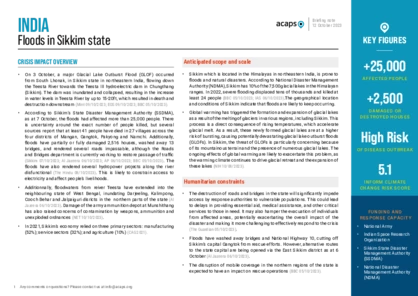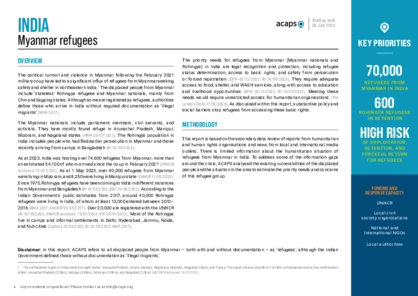Latest updates on country situation
03 June 2025
An early start to heavy monsoon-related rains in late May 2025 has triggered severe flooding and landslides across multiple states (Arunachal Pradesh, Assam, Himachal Pradesh, Jammu and Kashmir, Kerala, Manipur, Meghalaya, Mizoram, Nagaland, Sikkim, and Tripura). On 4 June, the National Emergency Response Centre reported 42 fatalities. Heavy rains continue in the northeast, resulting in further fatalities and damage. By 4 June, Assam state was the hardest hit, recording 11 fatalities, many from the landslides. Over 530,000 people are affected in Assam, 40% of whom are seeking shelter in emergency shelters and distribution centres. The Government has deployed army units for rescue and evacuation, but many areas remain inaccessible because of damaged roads and telecommunication disconnection. Heavy rainfall is expected to continue across the northeast, risking major riverine flooding, further affecting agriculture and livestock. Stagnant floodwaters have raised the threat of disease outbreaks, such as dengue and hepatitis A. (MHA 03/06/2025, ECHO 04/06/2025, IMD 04/06/2025, Sphere India 04/06/2025)
12 May 2025
On 10 May 2025, India and Pakistan reached a temporary ceasefire agreement, ending four days of fighting following the Indian-administered 22 April Pahalgam (Kashmir) attack. The clashes killed at least 46 civilians, injured over 90, and forced thousands to flee their homes. Despite the truce, residents remain anxious, fearing that violence could resume if the agreement fails. (Reuters 10/05/2025, AJ 12/05/2025, IR 09/05/2025)
01 October 2024
Since June 2024, India has been dealing with severe flooding in several states, killing over 160 people and causing significant damage and displacement. Heavy rains from the southwest monsoon have caused rivers to overflow, led to landslides, submerged villages, and disrupted transportation, telecommunications, and the electricity and water supply. The hardest-hit states are Assam, Bihar, Gujarat, Telangana, and Tripura; Tripura and Telangana report 53,195 and 9,608 damaged or destroyed houses, respectively. By early September, around 77,000 people required humanitarian assistance in Tripura alone, and over 80,000 people were displaced in Andhra Pradesh, Telangana, and Tripura. Flooding and landslides have also washed away 160,000 hectares of agricultural land in Tripura. Updated needs assessments are scarce. The people affected are scattered and will likely increase as states continue to experience flooding from monsoon rainfall. From 29–30 September, nearly 178,000 people were displaced, and over 639,000 people were affected in Assam, Bihar, Gujarat, Madhya Pradesh, Meghalaya, and Sikkim. The most urgent needs likely include food, shelter, drinking water, and protection. (ECHO 01/10/2024, MHA 01/10/2024, Sphere India 06/09/2024)
current crises
in
India
These crises have been identified through the INFORM Severity Index, a tool for measuring and comparing the severity of humanitarian crises globally.
IND007 - 2025 Monsoon Floods
Last updated 28/11/2025
Drivers
Floods
Crisis level
Country
Severity level
2.6 Medium
Access constraints
2.0
IND001 - Country Level
Last updated 28/11/2025
Drivers
Conflict/ Violence
Floods
Crisis level
Country
Severity level
2.7 Medium
Access constraints
4.0
IND002 - Conflict in Jammu Kashmir
Last updated 28/11/2025
Drivers
Conflict/ Violence
Crisis level
Country
Severity level
Access constraints
4.0
Analysis products
on
India
09 June 2025
India - Pakistan: 49 days since the escalation of hostilities in Kashmir region
DOCUMENT / PDF / 573 KB
This report provides an overview of how the crisis has evolved over the past 45 days since the Pahalgam attack in India-administered Kashmir on 22 April 2025. It is meant to highlight priority needs and humanitarian response constraints in both Indian-administered and Pakistan-administered Kashmir as a result of the escalating conflict between the two nations.
28 May 2024
Global increase of cholera: aggravated by vaccine shortage and El Niño
DOCUMENT / PDF / 341 KB
This report highlights the key contributing factors and aggravating conditions that can increase the global prevalence of cholera, focusing particularly on the impact of the global OCV shortage that is heightening humanitarian needs among affected populations and those vulnerable to spread.
Attached resources
12 October 2023
India: floods in Sikkim state
DOCUMENT / PDF / 256 KB
On 3 October, a major Glacial Lake Outburst Flood occurred from South Lhonak, in Sikkim state in northeastern India, flowing down the Teesta River towards the Teesta III hydroelectric dam in Chungthang (Sikkim). The dam was inundated and collapsed, resulting in the increase in water levels in Teesta River, which resulted in death and destruction downstream.
28 July 2023
India: Myanmar refugees
DOCUMENT / PDF / 859 KB
The political turmoil and violence in Myanmar following the February 2021 military coup have led to a significant influx of refugees from Myanmar seeking safety and shelter in northeastern India. The displaced people from Myanmar include ‘stateless’ Rohingya refugees and Myanmar nationals, mainly from Chin and Sagaing states.
18 May 2023
India: conflict in Manipur state
DOCUMENT / PDF / 376 KB
On 3 May 2023, the Kuki tribal group held an organised protest march in the northeastern Indian state of Manipur against the majority Meitei community being recognised as a Scheduled Tribe. The march resulted in violent clashes with the Meitei non-tribal group. Various sources indicate that an estimated 30,000–45,000 people have been forced to flee.






